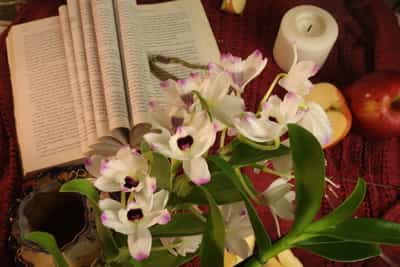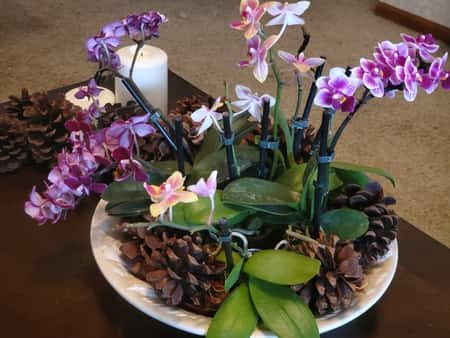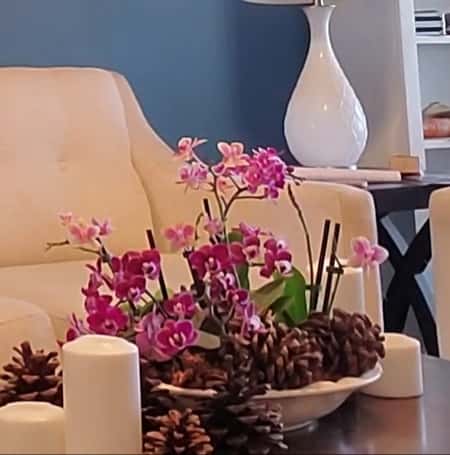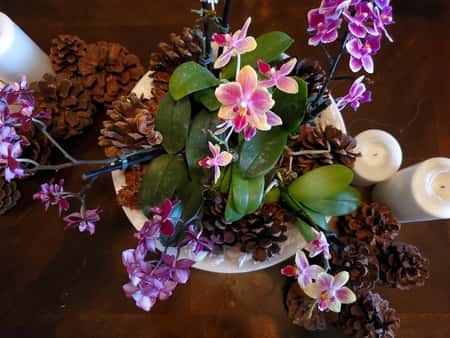Many floral designs show off multiple orchids potted together to display an elaborate, full presentation. Not only do multiple orchids in one community pot catch the eye, they inspire whoever sees your collection.

Yet, after growing orchids for some time, most orchid growers come to the question,
“Is it possible to cultivate two or more orchids in the same pot?
After all, one orchid by itself is tricky enough.”You can pot several orchids in the same pot, and the good news is that there are several ways to do this successfully. On the other hand, keeping them in individual pots is actually healthier and safer when it comes to treating problems like:
black rot,
mealy bugs,
aphids,
spider mites
and other pests
that can infest the orchid. It’s a delicate decision and the risks of loosing the orchids does increase when potting this way.
1. Individual Orchid Pots Hidden in One Community Pot
The first method is not actually potting two orchids together, but giving the impression they’re in one big pot. By hiding the individual plastic pots under Spanish moss, the floral design tricks the viewer into believing it’s one cohesive design. Yet the pots remain separate and potting medium is not shared.
Combining the multiple pots yet maintaining individuality has a very long list of pros and short list of cons. This method
facilitates your watering routine,
simplifies the way you’d manage humidity, pH,
and keeps your orchid separate as it would be on the shelf.
The only difference is that you wouldn’t see the space in between the orchids, since they are hidden under Spanish moss.
I use Spanish moss for these designs because Sphagnum moss doesn’t work as well as a top layer. For this design to work, the moss has to be applied as a thick layer, covering the empty space between the pots.
Spanish moss retains less water compared to Sphagnum. With this much sphagnum, the stem wouldn’t be exposed to air and would definitely present stem rot over time.

Just a note about the top layer:
Sphagnum works extremely well as a top layer when applied in a thin coating and maintaining distance from the stem. If you want to read about Sphagnum moss, check out this article, where I explain in more detail why it absorbs humidity, how it interacts with bark, and how the pH is maintained in the potting medium. Overall, sphagnum moss an excellent benefit to add to your potting medium, but just not as a top layer in collective pots.
2. Collective Pot (with the Same Potting Medium) for Multiple Orchids
The second method is potting two orchids together inside the same pot (which is the aim of this article). When doing this, there certainly are more cons than pros, but the overall look is worth the shot.
In this article, I’ll focus on the second method, since the first is quite self-explanatory (place separate pots together; add moss; done.)
Beware before you start: there are several items you need to avoid when potting, which could be a differentiating factor in whether the orchids live or die. The risks of loosing orchids when potted collective almost quadruples, so start with orchids that were not as expensive and with orchids that you won’t mind if they happen to knock on the Greenhouse’s Doors in the clouds.
If you look at this project more as an experiment than as a healthy way to cultivate orchids, you’ll be more satisfied in the long run.

You need to be aware of several factors when repotting two or more orchids in one community pot: same species, same humidity and light requirements, same maturity (age), same watering preferences, and same dormancy periods (although the latter is less disputable and can be waived).
Let’s look at each one of these items separately.
2A) Combine Orchids with Same Genus and Species
Multiple orchids in the same pot need to be of the same genus and species. Even different species inside the same genera are hard to keep alive when potted together.
This happens because one orchid could have more powerful roots, and would absorb more nutrients, leaving the second, weaker orchid lacking. It’s not uncommon to see one orchid thrive while another is hardly making it, yet they’re in the same pot.
It’s not about the potting media, it’s about the absorption process.
In nature, when not enough nutrients are available, orchids will compete for food. There is a phenomenon called allelopathy, where a plant will secrete enzymes, hormones, pheromones when placed by another plant.
Sometimes this relationship can be beneficial, and both plants will have an advantage from the proximity. When nutrients are low, the plants beside them release these micronutrients in the air.
Other times, it’s like being in a relationship with a toxic person: they will silently do everything in their power to hinder the growth of another person. Plants do this by releasing toxins in the air that deplete another plant’s health and growth.
How each plant relates to another is a whole scientific study, and the enzymes that they release as they interact with each other play a big difference in potting two orchids together.
This article on Wikipedia is very precise about allelopathy, if you want more information.
is very precise about allelopathy, if you want more information.
To be safe, plant the same genus and species of orchids together. This is the safest way to avoid “serial mass orchid deaths”.
2B) Combine Orchids with Same Humidity and Light Requirements
You’ll need to keep both orchids in the same place, so trying to plant an orchid with higher humidity requirements with one that has lower requirements won’t work. If you followed the first step, this step is unnecessary and there’s not much to explain.
Sadly, different orchid genera in the same pot only work if they are cut in a floral arrangement.
2C) Combine Orchids with Same Maturity (Age)
This tip is essential: if you plant two orchids in the same pot, an older one with more mature roots system, and a young keiki, the young plant will suffer to fight for its nutrients. It will be doing well to live off what wasn’t absorbed by the more mature plant.
There is a parenthesis for this item: keikis. If you plant the keiki in the mother plant’s pot for the first two years of its life, it will be beneficial to the keiki. The nutrients is something it’s already familiar with, since it will remain in the same pot the same as the mother.
The watering routine, the lighting, etc… nothing will change.
Since it was born under these conditions, it will adapt into a full plant easier being planted in the same pot as it’s mother.
If you are deciding to pot with keikis, read this article that explains how to pot keikis, when to remove them form the mother plant, and how to care for them until they reach full maturity.
If you decide to ignore everything I’ve said until now and plant an adult Phal with a mini Phal, the results are surprisingly somewhat positive, IF AND ONLY IF you have to make sure the mini gets enough water and fertilizer.
I’ve seen positive results with this, but I focused on the smaller plant and tended to its needs first.
Not only will the mature plant absorb most the nutrients, it also will fight for the sides of the pot. When more mature plants grow their roots, they will push away the roots from the younger plants. With the takeover, the younger plant will not find a way to stabilize itself, longing without success for the sides of the pot.

Remember all the tips about not potting an orchid in a pot that is too big?
Well, this is why:
the roots will not reach the side of the pot efficiently, and the orchid will not produce a bloom. Same happens with the pot being a community pot, and the orchid can’t reach the sides since the bigger orchid will have advantage.
2D) Combine Orchids with Same Watering Preferences
Watering is the number one reason I prefer to mount community pots with the first method, as individual pots. Yes, you have to destroy the floral arrangement every time you water, but you can water individually and know exactly how much water is needed for each orchid.
In a community pot with the same potting media, you’ll have to provide enough water to have both orchids completely happy.
But watering separately isn’t the only advantage.
Imagine if one orchid had mealybugs on it. You could easily remove the whole pot from the floral design, replace the vacancy with another orchid, and no harm done.
In a collective pot with multiple orchids, most all the orchids will soon develop the ailments that contaminated the first orchid. There is no way to treat one plant without treating them all. The risks you take are much bigger in losing your orchids as a community are larger in collective pots, rather than isolating it.
Since I am currently writing this article during the mandatory social isolation due to Coronavirus, I can relate. It’s better to be isolated and control the virus, limiting the spread of its influence, than to be around multiple people and spread the virus all over.
Anyway, the same happens to orchids, but their viruses aren’t curable. In this article about Ringspot Virus, you can see just how devastating it is to have one orchid get infected with a virus.
So, yes, social and herbal isolation is best.
Don’t Stop Learning!
If you want to be included in more information and get a 14-page fertilization guide, please sign up for my newsletter. I don’t spam, but send emails out bi-monthly with some curious topics of interest. If you want more information, click here to go to a specific page on this website where I explain it more in detail.

Also, if you are looking for an orchid journal to keep your notes specifically about orchid care, check out my 2 solutions for that on this page. If note-keeping isn’t your thing, then there is a free excel spreadsheet that you can download. Click here for more information on how to do that.
If you subscribe to my newsletter, I will send you a 14-page guide on the main tips of orchid fertilizer. It is downloadable and you can print it out on your computer. I designed the guide to double up as a coloring book, just to make it fun.
2E) Combine Orchids with Same Dormancy Periods
Since fertilization and watering all change during dormancy, you’ll need to pot the same dormancy period orchids together. The one thing you can’t change/swap/intercalate is the blooming cycle. After orchids come out of bloom, they’ll go into a quick dormancy period. (For more on dormancy, check out this article.)
This approach does work for orchids that have a small or non-existent dormancy cycle. If you have two Phalaenopsis, one which you bought in bloom during fall and the other was in bloom during spring, you can successfully pot them together and have a year-round floral design that is in bloom. This only works because Phalaenopsis don’t have a dormancy cycle.
If you proceed with different orchids, which go through dormancy cycles at distinct times of the year, your floral design will be ruined. Because while you’ll be watering one orchid that is in desperate need of water, the other orchid could be perfectly happy without. Root rot will occur on one, and since they’re in the same pot, fungus and bacteria will spread. Experiment and see what will works for you. That is the beauty of floral design. If you have a community pot with multiple orchids, and have cultivated it successfully, send a shout out or a picture in the comments below.
Happy Cultivating!


Hi, I read your article on putting orchids together because I wound up with 30 Phalenopsis. The house across the street was staged to sell. We had too much recycle and knowing they were not there any more my husband seeing their bin out went to put our over-flow in it. Opening it up he found the orchids just thrown in there. I was so upset by this that I rescued all of them. They could have at least put them out by the street. They were all in bloom and very healthy plants. Walkers would have happily taken some. To me this was just a crime to basically throw them out. Had we not opened that bin they would all be in a plant recycling center mangled and dead. I have been at resorts in Hawaii where they will have hugh planters filled with orchids and thought I could go on the web and find out how to do something like that. I found your site and I will follow the instructions for keeping them in separate pots but in a large flat container. I put a layer of pebbles under a wire shelf to keep the plants up out of the water to give them humidity. It is extremely dry here in California and I read that the phalenopsis should have about 70% humidity. Thank you for all of your information, if you can suggest anything else I would appreciate it. Mary
Hi Mary,
Wow, I am so glad you found those orchids! It’s so sad when that happens and a life of passion towards plants is just thrown away like that… Only if they knew how much $$ they were worth! LOL. As for the hanger, YOu’ll have to be watering it almost everyday. The wind and really dry climate are hard when it comes to mounted orchids, and these in the disguised pots are no exception. I think my only other advice would be to make sure they dont get full sun in the afternoon and it should thrive.
-Amanda
I planted one keiki a few years ago in its own pot. Now there are two orchids in the pot, both look to be close to the same size, and they seem to be joined at the base. Both have roots and both look healthy. They are laying slightly sideways in the pot. Have you ever heard of this? Can / should I cut them apart?
Thank you in advance for any information or advice.
Hello. Thank you for all your information. I rescued a couple orchids from the almost dead table at a home improvement store a year ago because i had always wanted to try raising orchids. I found this little pot around the base of the orchid and lots of styrofoam and rot. I held my breath and cut the rot off and gave them orchid bark and a pot with lots of holes. they lost their leaves but there was green at the bottom so they are alive and happy, I think. unfortunately my other half decided to by me orchids plural for my birthday, then more. this birthday he gave me 2 more. i had to say stop. I did end up planting 2 of the same size in the same pots because of lack of space. After reading your article I realize even though they seem happy together, they would be better off in two smaller pots in the big pot, that there is such thing as too much room. I really like your pine cone solution to put the orchids “together” but easy for watering day. I am about an hour north of tampa with no trees, but a huge front porch. I would like to have some of them hanging in an arrangement, but Im not sure what species of orchid would grow like that.
Thank you for sharing your knowledge and experience! I’m a first time orchid grower and bought myself several of the exact same cymbidium orchids planning to plant them into one big pot when a little more mature. Does the flowering of cymbidium orchids depend on how pot bound they are or on how many bulbs there are per plant?